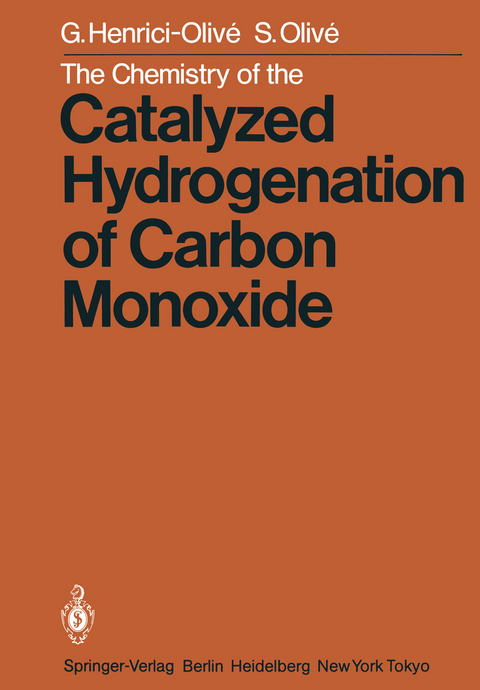
The Chemistry of the Catalyzed Hydrogenation of Carbon Monoxide
Springer Berlin (Verlag)
978-3-642-69664-0 (ISBN)
1 Introduction.- 1.1 References.- 2 Transition Metal-Hydrogen Interactions.- 2.1 Reaction of Hydrogen with Transition Metal Complexes and Surfaces.- 2.2 Metal-Hydrogen Bond Energy.- 2.3 Different Types of Metal-Hydrogen Bonding and the M-H Bond Length.- 2.4 Polarity of the M-H Bond.- 2.5 Mobility of Hydrogen Ligands.- 2.6 Conclusion.- 2.7 References.- 3 Transition Metal-Carbon Monoxide Interactions.- 3.1 The CO Molecule.- 3.2 Coordination Chemistry of CO in Molecular Complexes and Clusters.- 3.3 Molecular Carbon Monoxide on Metal Surfaces.- 3.4 CO Dissociation on Metal Surfaces.- 3.5 Conclusion.- 3.6 References.- 4 Non-Catalytic Interaction of CO with H2.- 4.1 On Metal Surfaces.- 4.2 CO/H2 Interaction in Transition Metal Complexes.- 4.3 Conclusions.- 4.4 References.- 5 Key Reactions in Catalysis.- 5.1 Oxidative Addition.- 5.2 Reductive Elimination.- 5.3 Migratory Insertion Reactions.- 5.4 Hydrogen Eliminiation Reactions.- 5.5 Ligand Influences.- 5.6 Conclusion.- 5.7 References.- 6 Catalysts and Supports.- 6.1 Molecular Complexes and Metal Surfaces - Analogies and Differences.- 6.2 Supported Metal Catalysts.- 6.3 Conclusions.- 6.4 References.- 7 Methanation.- 7.1 Carbide Mechanism.- 7.2 CO Insertion Mechanism.- 7.3 Inverse H/D Isotope Effects.- 7.4 Conclusion.- 7.5 References.- 8 Methanol from CO + H2.- 8.1 Nondissociative Incorporation of CO.- 8.2 Homogeneous Methanol Formation.- 8.3 Methanol Synthesis with Supported Noble Metal Catalysts.- 8.4 Synergism in the Cu/ZnO Catalyst.- 8.5 Conclusions.- 8.6 References.- 9 Fischer-Tropsch Synthesis.- 9.1 Early Developments and Present State of Commercial Fischer-Tropsch Synthesis.- 9.2 The Products of the FT Synthesis.- 9.3 Distribution of Molecular Weights.- 9.4 Kinetics and Thermodynamics of the FT Reaction.- 9.5 ReactionMechanism.- 9.6 Influence of the Dispersity of Metal Centers.- 9.7 Influence of the Temperature and Pressure.- 9.8 The Role of Alkali Promoters.- 9.9 Product Selectivity.- 9.10 Conclusion.- 9.11 References.- 10 Homogeneous CO Hydrogenation.- 10.1 Hydroformylation of Olefins (Oxo Reaction).- 10.2 Hydroformylation of Formaldehyde.- 10.3 Polyalcohols from CO + H2, and Related Homogeneous Syntheses.- 10.4 Conclusion.- 10.5 References.- 11 Methanol as Raw Material.- 11.1 Carbonylation of Methanol (Acetic Acid Synthesis)..- 11.2 Methanol Homologation.- 11.3 Hydrocarbons from Methanol Dehydration and Condensation.- 11.4 Conclusion.- 11.5 References.- 12 Attempt of a Unified View.- 12.1 References.- 13 Subject Index.
| Erscheint lt. Verlag | 7.12.2011 |
|---|---|
| Zusatzinfo | X, 232 p. |
| Verlagsort | Berlin |
| Sprache | englisch |
| Maße | 170 x 244 mm |
| Gewicht | 434 g |
| Themenwelt | Naturwissenschaften ► Chemie ► Anorganische Chemie |
| Technik ► Maschinenbau | |
| Schlagworte | carbon • Chemistry • Coordination Chemistry • Dynamics • Energy • Katalysator • Kinetics • Kohlehydrierung • metals • Methanol • noble metal • oxygen • Ruthenium • Surfaces • Transition metal |
| ISBN-10 | 3-642-69664-3 / 3642696643 |
| ISBN-13 | 978-3-642-69664-0 / 9783642696640 |
| Zustand | Neuware |
| Haben Sie eine Frage zum Produkt? |
aus dem Bereich


